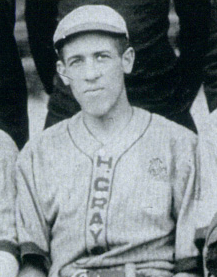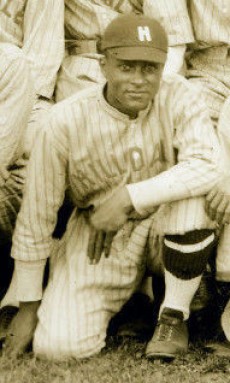
Oscar McKinley Charleston was an American center fielder and manager in Negro league baseball. Over his 43-year baseball career, Charleston played or managed with more than a dozen teams, including the Homestead Grays and the Pittsburgh Crawfords, Negro league baseball's leading teams in the 1930s. He also played nine winter seasons in Cuba and in numerous exhibition games against white major leaguers. He was posthumously inducted into the National Baseball Hall of Fame in 1976.

Joshua Gibson was an American baseball catcher primarily in the Negro leagues. In 1972, he became the second Negro league player to be inducted in the National Baseball Hall of Fame.
The Pittsburgh Crawfords, popularly known as the Craws, were a professional Negro league baseball team based in Pittsburgh, Pennsylvania. The team, previously known as the Crawford Colored Giants, was named after the Crawford Bath House, a recreation center in the Crawford neighborhood of Pittsburgh's Hill District.
The Homestead Grays were a professional baseball team that played in the Negro leagues in the United States.

William Julius "Judy" Johnson was an American professional third baseman and manager whose career in Negro league baseball spanned 17 seasons, from 1921 to 1937. Slight of build, Johnson never developed as a power threat but achieved his greatest success as a contact hitter and an intuitive defenseman. Johnson is regarded as one of the greatest third basemen of the Negro leagues. In 1975, he was elected into the Baseball Hall of Fame after being nominated by the Negro Leagues Committee.

Ernest Judson Wilson, nicknamed "Boojum", was an American third baseman, first baseman, and manager in Negro league baseball. He played for the Baltimore Black Sox, the Homestead Grays, and the Philadelphia Stars between 1922 and 1945. Wilson was known for possessing a unique physique, a quick temper, and outstanding hitting skills. One of the Negro leagues' most powerful hitters, his career batting average of .351 ranks him among the top five players.

The East–West All-Star Game was an annual all-star game for Negro league baseball players. The game was the brainchild of Gus Greenlee, owner of the Pittsburgh Crawfords. In 1933 he decided to emulate the Major League Baseball All-Star Game, using Negro league players. Newspaper balloting was set up to allow the fans to choose the starting lineups for that first game, a tradition that continued through the series' end in 1962. Unlike the MLB All-Star game which is played near the middle of the season, the Negro All-Star game was held toward the end of the season.

Cumberland Willis "Cum" Posey Jr. was an American baseball player, manager, and team owner in the Negro leagues, as well as a professional basketball player and team owner.
Greenlee Field in Pittsburgh, Pennsylvania, was one of only a few Black-built and Black-owned major league baseball fields in the United States. The field was the dream of Gus Greenlee, owner of the Pittsburgh Crawfords.

Raymond Brown was an American right-handed pitcher in Negro league baseball, almost exclusively for the Homestead Grays.

The Detroit Wolves were a Negro league baseball club that played for the 1932 season only.
The East–West League was an American Negro baseball league that operated during the period when professional baseball in the United States was segregated. Cum Posey organized the league in 1932, but it did not last the full year and folded in June of that year. It was the first Negro league to include teams from both the Eastern and Midwestern United States.

Samuel Howard Bankhead was an American baseball player in the Negro leagues. He played from 1931 to 1951. He also played for the Dragones de Ciudad Trujillo along with Satchel Paige and Josh Gibson. In 1951, he became the first black coach in Minor League Baseball when he was a player-manager for the Farnham Pirates of the Provincial League. He played in several East-West all-star games from 1933 to 1946.

Paul Eugene "Country Jake" Stephens was an American baseball player known for his slight stature, speed, and defense at the shortstop position. He played in the Negro leagues for 4 teams (1921–1937).
Joshua Gibson Jr. was an African-American baseball infielder in the Negro leagues. He played for the Homestead Grays in 1949, 1950 and 1952. He also played with the Farnham Pirates in the Provincial League in 1951. His father, Hall of Famer Josh Gibson Sr., played in the Negro leagues, and is considered one of the greatest power hitters in baseball history.

Theodore Roosevelt Page, nicknamed "Terrible Ted", was an American baseball player. From 1923 to 1937, Page played for numerous Negro league teams, including the Homestead Grays and Pittsburgh Crawfords. On a 1986 Larry Fritsch baseball card, “…Page is regarded as one of the best outfielders ever to play the game.” He is a member of the Pennsylvania Sports Hall of Fame.
The following is a timeline of the history of the city of Pittsburgh, Pennsylvania, US.
Fogel Field was a baseball park located in Hot Springs, Arkansas, utilized for spring training games and baseball camps between 1912 and 1952. The site was also known as Fordyce Field and Holder Field. Fogel Field was built in 1912 as a spring training site for Major League Baseball teams. The field was named for Horace Fogel, President of the Philadelphia Phillies. Fogel Field hosted the Phillies (1912) and the Pittsburgh Pirates. The Kansas City Monarchs (1928), Homestead Grays (1930–1931) and Pittsburgh Crawfords (1932–1935) of Negro league baseball also used Fogel Field as their spring training site.
The 1930 Homestead Grays baseball team competed as an independent in Negro league baseball during the 1930 baseball season. The team compiled a 45–15–1 (.746) record.











